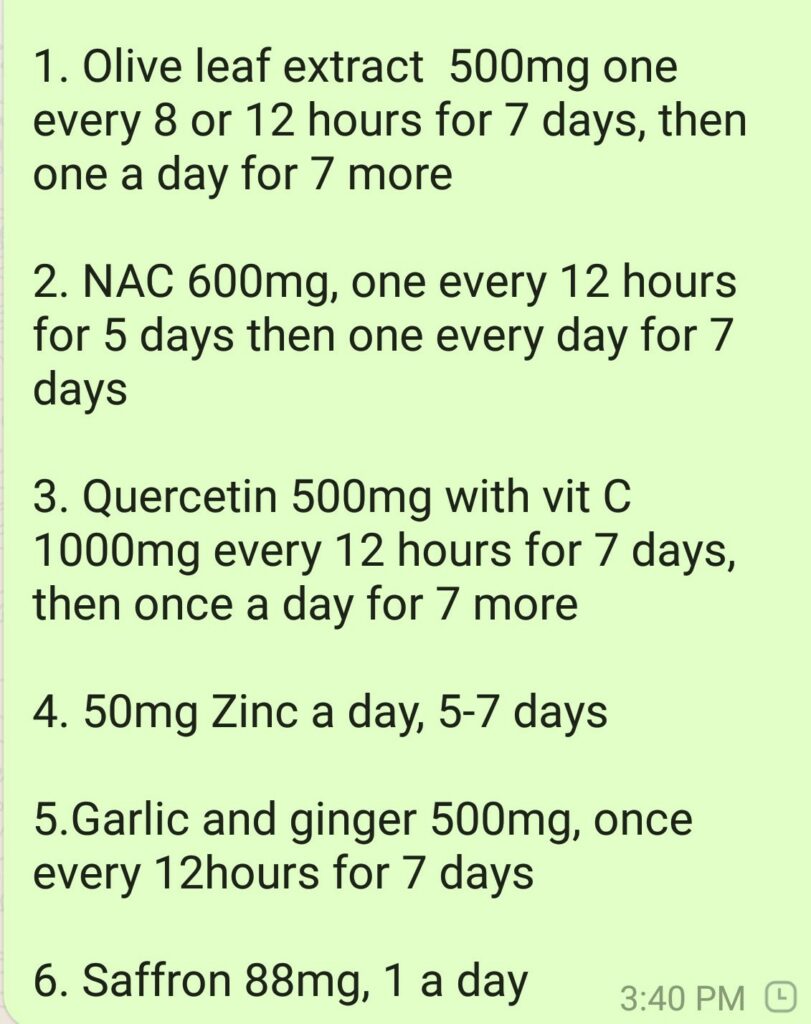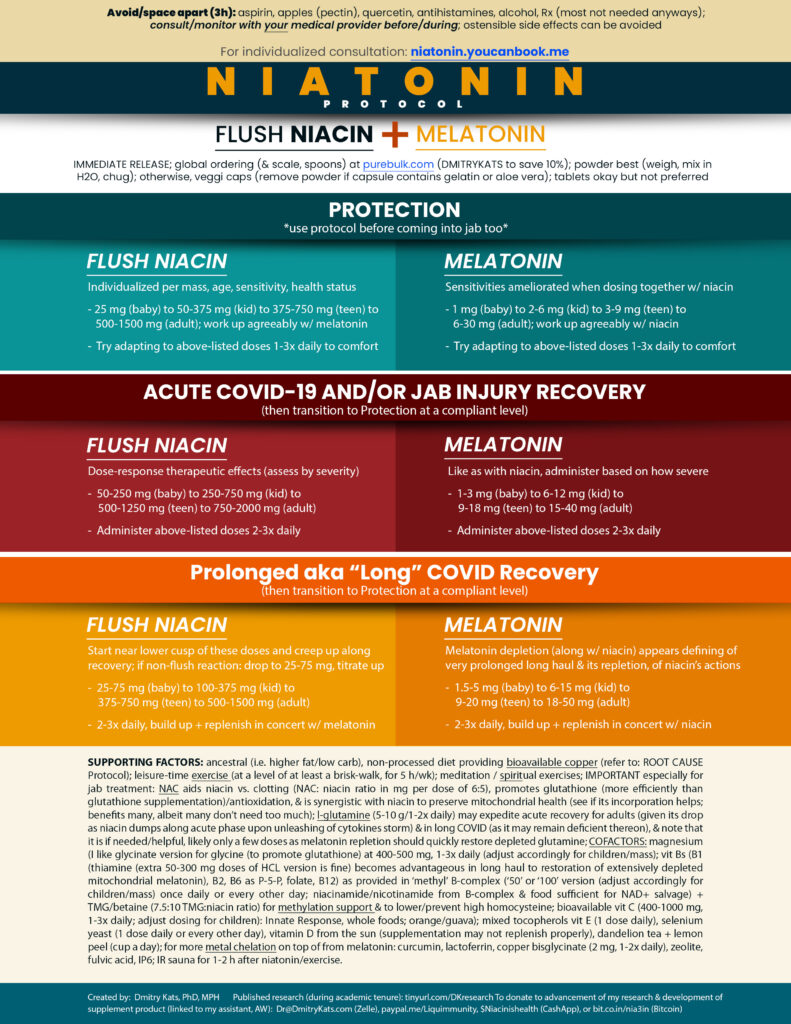The spike protein may be rapidly increasing aging by affecting the length of telomerase, a topic discussed in a previous post with potential dietary/phytonutrient aids. EGCG and other nutrients that promote the Nrf2 gene or protein have protective effects growth and repair and immune function. In the process of reorganizing the Spike protein Risks & Aids – Summary List into a spreadsheet,* a pattern emerged in the various phytonutrient and other aids – they promote Nrf2 and inhibit NFkB along with the rest of the circadian cycle promoting lifestyle factors.
- *Spike protein Risks & Aids – Summary List into a spreadsheet, * To read each box of the table click on the box and a drop down window should appear with all the text whether brief or a long list of references.
- The vitamins, minerals, and TMG & DMG, have dosing details listed now on a new page of my jenniferdepew.com/nutrients site with dosing ranges and links for food sources and more info if interested.
- I will add another page for the phytonutrients, antioxidants, and cofactors, or maybe a few pages. goals
- Various covid19 protocols are listed on this site: https://c19protocols.com/author/c19prot/
*Addition – 8/30/2021 article about the senescence effect of the spike protein: Le SARS-COV2 accélérerait l’âge biologique – SARS-COV2 would accelerate biological age, (FranceSoir), translated from French, written by a group that includes Nobel Prize winning scientist Luc Montagnie, (2008 Nobel Prize in Medicine) and Walter Chesnut whose work is included in earlier posts on this site; Xavier Azalbert, Anne-Typhaine Bouthors, Michel Brack, Dominique Cerdan, Walter Chesnut, Gérard Guillaume, Jean-François Lesgards, Luc Montagnier, Jean-Claude Perez for FranceSoir.
~
Modern life seems to be the underlying theme of what is a risk factor and what might help – return to more ancient darkness for sleep, get full spectrum light with UV for 15-30 minutes per day, in the morning hours of your day may be ideal. Adequate iodine and magnesium is needed to help the body not have a calcified pineal gland and the pineal gland is needed to make melatonin. Melatonin is needed for immune function and has a role in energy production and inflammation removal involving niacin and the Citric Acid Cycle. Melatonin can be taken as a supplement however, then your body may be even less likely to make its own – working on improving pineal health and nighttime darkness (eye mask if need be, but covering the skin is needed too, we can sense light with photosensitive skin receptors).
Metabolic Syndrome involves magnesium deficiency, which increases hypertension and insulin resistance. The Citric Acid Cycle uses glucose to provide ATP for cellular energy or to be released as heat by a special type of adipose tissue called brown fat. People living in cold climates who spend time in the cold tend to have larger amounts of brown fat then people living in warm climates. The niacin receptor is involved in ‘uncoupling’ the Citric Acid Cycle from producing ATP as energy storage units and instead releasing it directly as warmth. The heat and reddening of the skin during a niacin flush is an example of the release of energy as heat.
There are many cofactors necessary for the Citric Acid Cycle, the chemical pathways used by mitochondria for the release of energy from glucose. The cofactors almost all also are promoters of the anti-inflammatory Nrf2 pathways, although the levels of a few minerals are regulated by Nrf2. Excess copper or iron can be inflammatory. So making sure the diet has plenty of the food sources or supplements of all the various cofactors is helping the body remove inflammation directly within mitochondria to be released as a little extra warmth, and also to produce energy for cellular use, and your thinking and daily activity.
It may also be protective during times of infection to have adequate Nrf2 and Citric Acid Cycle capacity, and also adequate uncoupling capacity: adequate niacin and/or butyrate to activate the GP109 receptors that are involved in the mitochondrial energy uncoupling, so the excess energy from oxidative stress chemicals or free iron, can be released as fairly harmless heat instead of transferred to ATP molecules. The heat during a fever is from a different cause than the temporary warmth experienced after taking a high dose of niacin – which gets milder after having been using it for a while, and is milder when there is adequate melatonin present.
About the spreadsheet & reading it – the organization style.
This is the very initial stage of writing, and many of the references are new additions. I am sharing it early because it may help people and: Pain hurts, health is better, and health is worth some effort, even a lot of effort.
The spreadsheet has categories of What? is the problem, symptom, negative effect of the spike protein, in rows. Each category often had more than one and sometimes many aids that might help or be a negative factor, so the spreadsheet is extended into many columns so each aid or lifestyle factor could have its own individual column. The columns have an ‘x‘ for the category if it is an aid and there may be a note if the item is otherwise affected by the category. Some aids may help many types of problems, inflammation and direct anti-viral for example, so there would be an ‘x‘ in the inflammation category and an anti-viral category. Each box in the columns has references about that aid and how it relates to the category. Eventually this will be useful for writing an organized reference list and document or app of some sort.
Yes this is complex, not just one or two supplements to take – breaking news – life is a miracle, it is amazing that any of us function at all. Given that, we do know a lot about what might help prevent illness or chronic degeneration, if we are allowed to put it into individual self care practice. Individualized care means – Pay attention to what seems to help and stick with that, possibly with breaks occasionally or rotating things over days, weeks or months, in season or what seems particularly good at that time.
Rotating favorites can be protective, or herbal supplements too maybe. Sensitivities to foods or substances are more likely to occur with something eaten every single day or very often. On average wheat and corn, eggs and dairy are in foods commonly eaten at every meal.
Other nutrient supplements are needed daily because they are water soluble. Some are found in many common foods and generally are rarely deficient – except during times of severe malnutrition or infection – thiamine, B1, is one of those. Vitamin C needs are also incredibly increased during severe infection or inflammation, in part because our own production of antioxidants is reduced, we normally make far more than we would ever get from a vitamin C food or capsule (equivalent to 300 orange’s worth of vitamin C, approximately per day for normal health, but glutathione and other antioxidants).
The B vitamins and C are water soluble and magnesium is readily lost in sweat and urine so we need that daily similarly to potassium and sodium, like an electrolyte – to help maintain good fluid balance. We also need calcium regularly but the bones are storage account for both magnesium and calcium so an acute or chronic deficiency is less obvious than for sodium and potassium. Very acute magnesium deficiency can occur during strenuous exercise on a hot day, and cause death from a stroke. Ischemic stroke led to death due to any reason more often in hospitalized patients with lower magnesium levels, than for those with higher levels. (ref)
Via @DGrouf Dr Grouf

via Dmitry Katz, PhD: Niacin, NA, within a cell, graphic. The green oval is an endolysosome, (hopefully removing spike protein), and it is complex… :-)

Protocol by Dmitry Katz, PhD focuses on melatonin and recommends a high dose of it. There may be a risk that a person starts making less of their own. Focu
Also using blackout curtains at night with no little lights or alarm clock, or using an eyemask during sleep can help us make our own melatonin. Supplements might be useful if there was a lack of sleep night. The melatonin helps the niacin flush reaction be milder. I have found high dose niacin helpful, see an earlier post https://transcendingsquare.com/2021/01/22/niacin-early-treatment-in-general-for-sars-cov-2-is-sensible-reduces-hospitalization-and-mortality-rate/ for more information, and some precautions.

How to get started on the niacin part of the protocol and cautions about potential side effects and medications that may increase risk of side effects is available in this post: Niacin, & early treatment in general for SARS-CoV-2 is sensible, reduces hospitalization and mortality rate. Jan 22, 2021.
Disclaimer: Information shared for educational purposes within the guidelines of Fair Use. It is not intended as individual health guidance, please see a health care professional for individualized guidance. ‘Functional medicine’ practitioners work to restore normal function, nutritional adequacy and modify other lifestyle factors that might be part of a health problem.
Reference List
- You S, Zhong C, Du H, Zhang Y, Zheng D, Wang X, Qiu C, Zhao H, Cao Y, Liu C, -F: Admission Low Magnesium Level Is Associated with In-Hospital Mortality in Acute Ischemic Stroke Patients. Cerebrovasc Dis 2017;44:35-42. doi: 10.1159/000471858 https://www.karger.com/Article/Abstract/471858
